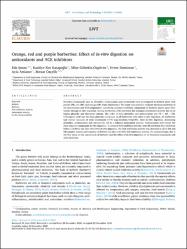Orange, red and purple barberries: Effect of in-vitro digestion on antioxidants and ACE inhibitors

View/
Date
2021Author
Şensu, EdaKasapoğlu, Kadriye Nur
Gültekin Özgüven, Mine
Demircan, Evren
Arslaner, Ayla
Özçelik, Beraat
Metadata
Show full item recordAbstract
Bioactive compounds such as phenolics, anthocyanins and carotenoids were investigated in Berberis plant with
purple (PB), red (RB) and orange (OB) fruits (barberries). The study was aimed to evaluate the bioaccessibility of
the antioxidants and ACE (angiotensin converting enzyme) inhibitory compounds of barberry plants upon their
transit through in-vitro digestion. Among barberries, (PB) exhibited the strongest antioxidant activity due to its
higher phenolic and flavonoid content. The order of total phenolics and anthocyanins was PB > RB > OB.
Chlorogenic acid was the main phenolic compound in all barberries even after in-vitro digestion. All barberries
had similar amounts of total carotenoids (4.45 mgβ-carotene/100gDW). After in-vitro digestion, decreasing
phenolics, anthocyanins and carotenoids led to a reduced antioxidant activity. Anthocyanins were found the
most sensitive compounds in-vitro digestion. In terms of ACE inhibition activity, only RB exhibited ACE inhibition
before (73.84%) and after (65.51%) in-vitro digestion. No ACE inhibition activity was detected at all in RB and
OB samples. Leaves and branches of Berberis had also over 50% ACE inhibitory activity. To our knowledge, this is
the first study on the carotenoids of barberry and the effect of in-vitro digestion on its bioactive compounds and
ACE inhibitors.
Volume
140Collections
The following license files are associated with this item:

















